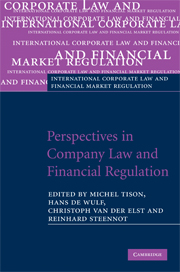Book contents
- Frontmatter
- Contents
- List of contributors
- Foreword
- PART I Perspectives in company law, SECTION 1: European company law: regulatory competition and free movement of companies
- PART 1 Perspectives in company law, SECTION 2: Corporate governance, shareholders' rights and auditing
- PART 1 Perspectives in company law, SECTION 3: Takeover law
- PART II Perspectives in financial regulation, SECTION 1: European perspectives
- PART 2 Perspectives in financial regulation, SECTION 2: Transatlantic perspectives
- 28 Learning from Eddy: a meditation upon organizational reform of financial supervision in Europe
- 29 The SEC embraces mutual recognition
- 30 Steps toward the Europeanization of US securities regulation, with thoughts on the evolution and design of a multinational securities regulator
- 31 The subprime crisis – does it ask for more regulation?
- 32 Juries and the political economy of legal origin
- PART III Miscellaneous
- Index
- References
28 - Learning from Eddy: a meditation upon organizational reform of financial supervision in Europe
from PART 2 - Perspectives in financial regulation, SECTION 2: Transatlantic perspectives
Published online by Cambridge University Press: 04 August 2010
- Frontmatter
- Contents
- List of contributors
- Foreword
- PART I Perspectives in company law, SECTION 1: European company law: regulatory competition and free movement of companies
- PART 1 Perspectives in company law, SECTION 2: Corporate governance, shareholders' rights and auditing
- PART 1 Perspectives in company law, SECTION 3: Takeover law
- PART II Perspectives in financial regulation, SECTION 1: European perspectives
- PART 2 Perspectives in financial regulation, SECTION 2: Transatlantic perspectives
- 28 Learning from Eddy: a meditation upon organizational reform of financial supervision in Europe
- 29 The SEC embraces mutual recognition
- 30 Steps toward the Europeanization of US securities regulation, with thoughts on the evolution and design of a multinational securities regulator
- 31 The subprime crisis – does it ask for more regulation?
- 32 Juries and the political economy of legal origin
- PART III Miscellaneous
- Index
- References
Summary
With the March 2008 release of the US Treasury Department's Blueprint for a Modernized Financial Regulatory Structure, the reorganization of financial regulation in the United States is, once again, an issue of public debate in American policy circles. Fortunately, this is also a subject which Eddy Wymeersch recently addressed in The Structure of Financial Supervision in Europe: About Single Financial Supervisors, Twin Peaks and Multiple Financial Supervisors. Like much of Professor Wymeersch's academic writing, this article offers American readers a unique and illuminating view into European regulatory practice, combining the theoretical sophistication of an accomplished academic with the pragmatic insights of a senior regulatory official. My goal in this chapter is to meditate upon Professor Wymeersch's description of the evolving supervisory practices in Europe and draw out potentially useful implications for policy issues raised in the Treasury Department's Blueprint and how regulatory reform might be implemented in the United States.
At the outset I should acknowledge the envy with which I regard my academic and regulatory counterparts working in other jurisdictions. While the United States prides itself in having a dynamic economy that fosters innovation and invention, the country's capacity to reform the structure of its regulatory institutions pales in comparison to the ability of member states of the European Union – or other developed countries such as Japan and Australia – to modernize their regulatory bodies.
- Type
- Chapter
- Information
- Perspectives in Company Law and Financial Regulation , pp. 523 - 539Publisher: Cambridge University PressPrint publication year: 2009
References
- 1
- Cited by

